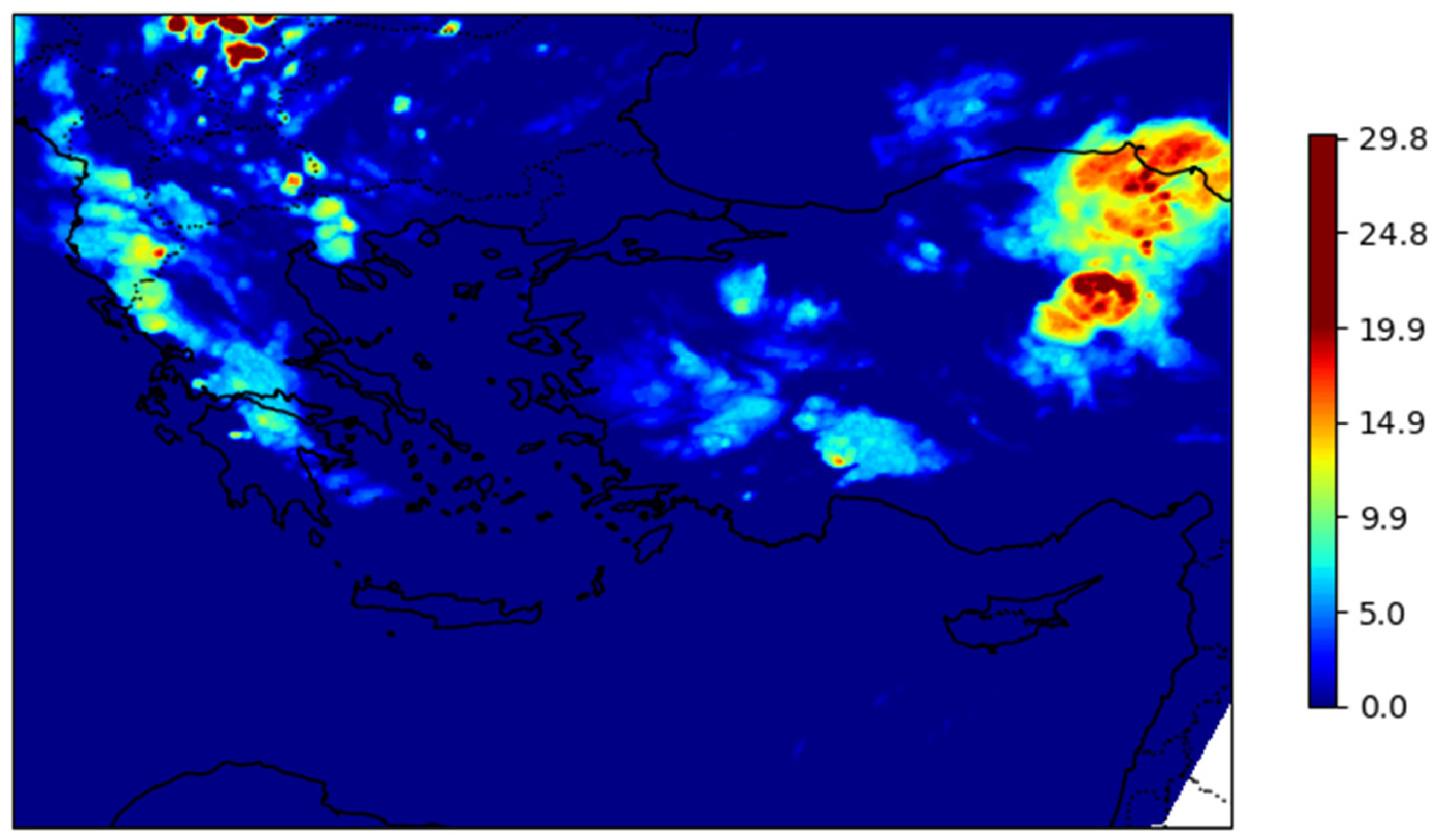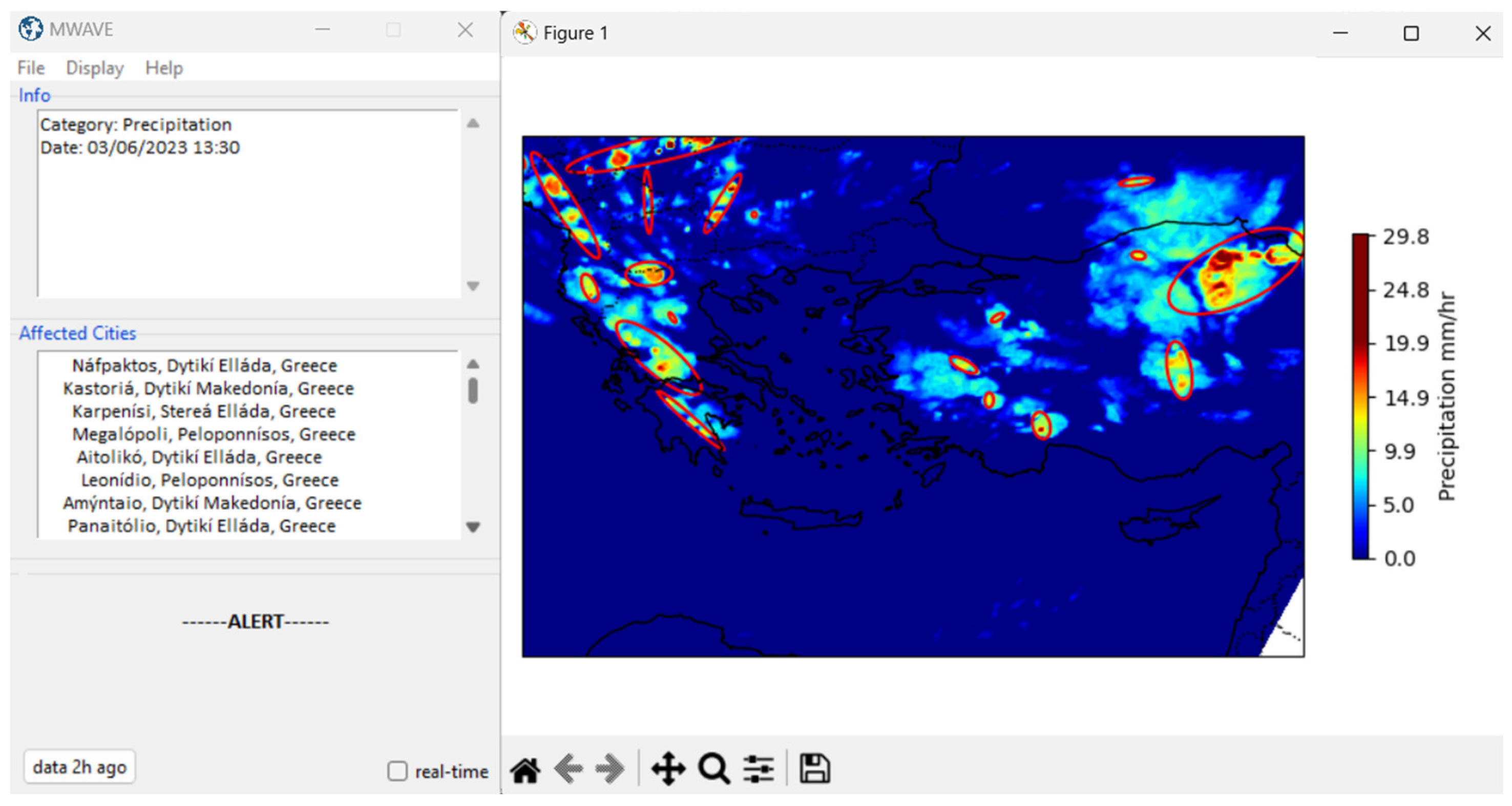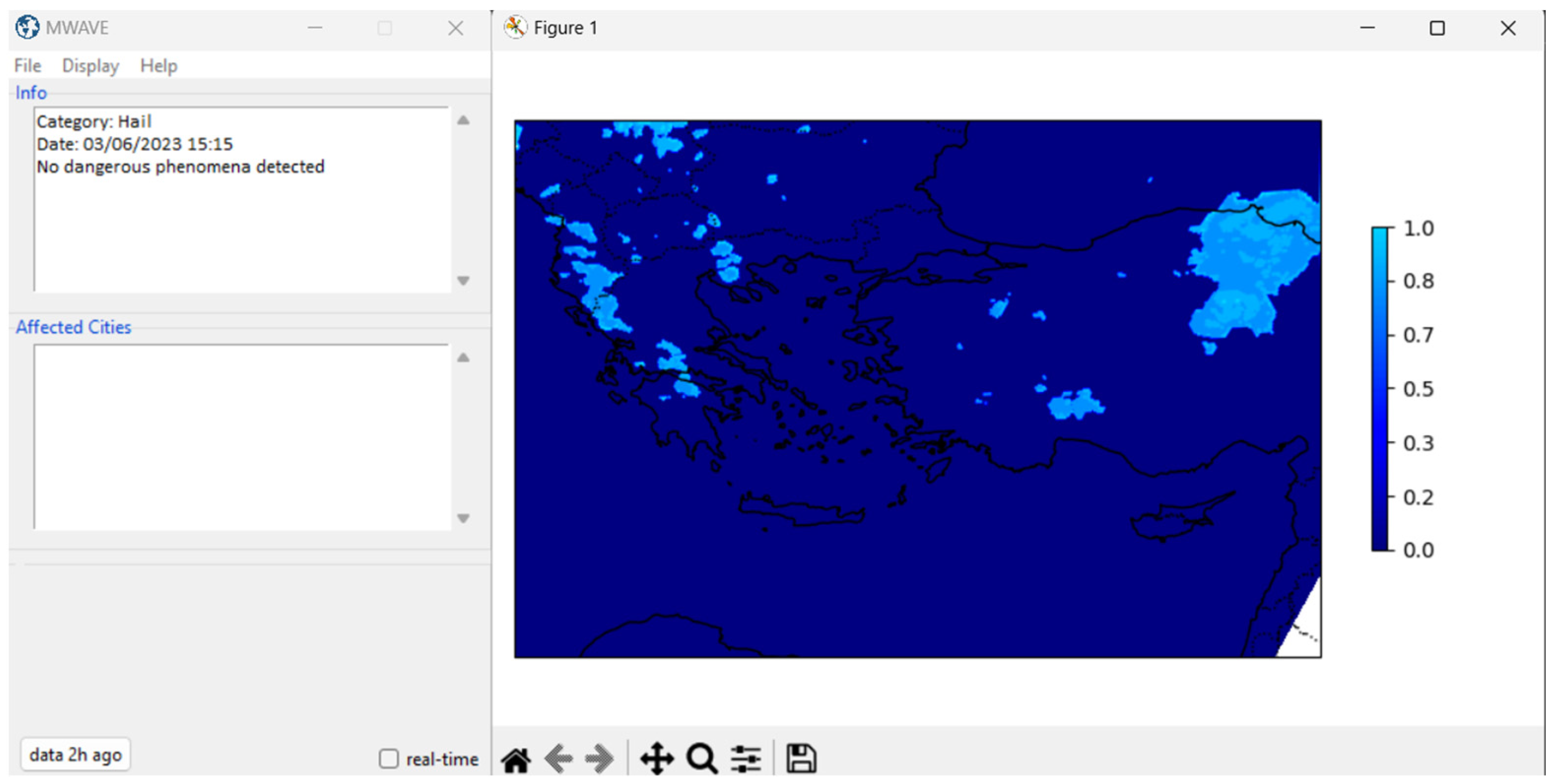Automated Application for Visualizing Rainfall and Hail Estimations Derived from an Algorithm Based on Meteosat Multispectral Image Data †
Abstract
:1. Introduction
2. Data and Methods
3. Results and Discussion
4. Conclusions
Author Contributions
Funding
Institutional Review Board Statement
Informed Consent Statement
Data Availability Statement
Acknowledgments
Conflicts of Interest
References
- Scarino, B.; Itterly, K.; Bedka, K.; Homeyer, C.R.; Allen, J.; Bang, S.; Cecil, D. Deriving Severe Hail Likelihood from Satellite Observations and Model Reanalysis Parameters Using a Deep Neural Network. Artif. Intell. Earth Syst. 2023, 2, 220042. [Google Scholar] [CrossRef]
- Batbold, C.; Yumimoto, K.; Chonokhuu, S.; Byambaa, B.; Avirmed, B.; Ganbat, S.; Kaneyasu, N.; Matsumi, Y.; Yasunari, T.J.; Taniguchi, K.; et al. Spatiotemporal Dispersion of Local-Scale Dust from the Erdenet Mine in Mongolia Detected by Himawari-8 Geostationary Satellite. SOLA 2022, 18, 225–230. [Google Scholar] [CrossRef]
- Xu, G.; Zhong, X. Real-Time Wildfire Detection and Tracking in Australia Using Geostationary Satellite: Himawari-8. Remote Sens. Lett. 2017, 8, 1052–1061. [Google Scholar] [CrossRef]
- Gosset, M.; Dibi-Anoh, P.A.; Schumann, G.; Hostache, R.; Paris, A.; Zahiri, E.-P.; Kacou, M.; Gal, L. Hydrometeorological Extreme Events in Africa: The Role of Satellite Observations for Monitoring Pluvial and Fluvial Flood Risk. Surv. Geophys. 2023, 44, 197–223. [Google Scholar] [CrossRef]
- Jeyaseelan, A. Droughts and Floods Assessment and Monitoring using Remote Sensing and GIS. In Proceedings of Satellite Remote Sensing and GIS Applications in Agricultural Meteorology, Dehra Dun, India, 7–11 July 2003; pp. 291–313. [Google Scholar]
- Marengo, J.A.; Alves, L.M.; Ambrizzi, T.; Young, A.; Barreto, N.J.C.; Ramos, A.M. Trends in Extreme Rainfall and Hydrogeometeorological Disasters in the Metropolitan Area of São Paulo: A Review. Ann. N. Y. Acad. Sci. 2020, 1472, 5–20. [Google Scholar] [CrossRef] [PubMed]
- Martha, T.; Roy, P.; Khanna, K.; Kotteeswaran, M.; vinod Kumar, K. Landslides Mapped from Satellite Data in the Western Ghats of Indian Peninsula after the August 2018 Excess Rainfall. Curr. Sci. 2019, 117, 804–812. [Google Scholar] [CrossRef]
- Zhou, J.; Bgood, J.; Shelton, S.; Holden, Z.; Sankaran, S. Aerial Multispectral Imaging for Crop Hail Damage Assessment in Potato. Comput. Electron. Agric. 2016, 127, 406–412. [Google Scholar] [CrossRef]
- Peters, A.J.; Griffin, S.C.; Viña, A.; Ji, L. Use of Remotely Sensed Data for Assessing Crop Hail Damage. Photogramm. Eng. Remote Sens. 2000, 66, 1349–1355. [Google Scholar]
- Hohl, R.; Schiesser, H.-H.; Knepper, I. The Use of Weather Radars to Estimate Hail Damage to Automobiles: An Exploratory Study in Switzerland. Atmos. Res. 2002, 61, 215–238. [Google Scholar] [CrossRef]
- Hohl, R.; Schiesser, H.-H.; Aller, D. Hailfall: The Relationship between Radar-Derived Hail Kinetic Energy and Hail Damage to Buildings. Atmos. Res. 2002, 63, 177–207. [Google Scholar] [CrossRef]
- Kolios, S. Hail Detection from Meteosat Satellite Imagery Using a Deep Learning Neural Network and a New Remote Sensing Index. Adv. Space Res. 2023, 72, 3009–3021. [Google Scholar] [CrossRef]
- Kolios, S.; Hatzianastassiou, N.; Lolis, C.J.; Bartzokas, A. Accuracy Assessment of a Satellite-Based Rain Estimation Algorithm Using a Network of Meteorological Stations over Epirus Region, Greece. Atmosphere 2022, 13, 1286. [Google Scholar] [CrossRef]
- The Pandas Development Team. Pandas-Dev/Pandas: Pandas. 2020. Available online: https://zenodo.org/records/10426137 (accessed on 27 September 2023).
- Hunter, J. Matplotlib: A 2D Graphics Environment. Comput. Sci. Eng. 2007, 9, 90–95. [Google Scholar] [CrossRef]
- Office, M. Cartopy: A cartographic python library with a Matplotlib interface. Exeter, Devon, v0.16 edition 2010–2017. Available online: http://scitools.org.uk/cartopy (accessed on 27 September 2023).
- Pedregosa, F.; Varoquaux, G.; Gramfort, A.; Michel, V.; Thirion, B.; Grisel, O.; Blondel, M.; Prettenhofer, P.; Weiss, R.; Dubourg, V.; et al. Scikit-Learn: Machine Learning in Python. Machine Learning in Python. J. Mach. Learn. Res. 2011, 12, 2825–2830. [Google Scholar]
- Clark, A. Pillow (PIL Fork) Documentation. Available online: https://buildmedia.readthedocs.org/media/pdf/pillow/latest/pillow.pdf (accessed on 27 September 2023).
- Kolios, S.; Hatzianastassiou, N. Quantitative Aerosol Optical Depth detection during dust outbreaks from Meteosat imagery using an Artificial Neural Network model. Remote Sens. 2019, 11, 1022. [Google Scholar] [CrossRef]



Disclaimer/Publisher’s Note: The statements, opinions and data contained in all publications are solely those of the individual author(s) and contributor(s) and not of MDPI and/or the editor(s). MDPI and/or the editor(s) disclaim responsibility for any injury to people or property resulting from any ideas, methods, instructions or products referred to in the content. |
© 2023 by the authors. Licensee MDPI, Basel, Switzerland. This article is an open access article distributed under the terms and conditions of the Creative Commons Attribution (CC BY) license (https://creativecommons.org/licenses/by/4.0/).
Share and Cite
Papavasileiou, N.; Kolios, S. Automated Application for Visualizing Rainfall and Hail Estimations Derived from an Algorithm Based on Meteosat Multispectral Image Data. Environ. Sci. Proc. 2023, 27, 8. https://doi.org/10.3390/ecas2023-15383
Papavasileiou N, Kolios S. Automated Application for Visualizing Rainfall and Hail Estimations Derived from an Algorithm Based on Meteosat Multispectral Image Data. Environmental Sciences Proceedings. 2023; 27(1):8. https://doi.org/10.3390/ecas2023-15383
Chicago/Turabian StylePapavasileiou, Niki, and Stavros Kolios. 2023. "Automated Application for Visualizing Rainfall and Hail Estimations Derived from an Algorithm Based on Meteosat Multispectral Image Data" Environmental Sciences Proceedings 27, no. 1: 8. https://doi.org/10.3390/ecas2023-15383
APA StylePapavasileiou, N., & Kolios, S. (2023). Automated Application for Visualizing Rainfall and Hail Estimations Derived from an Algorithm Based on Meteosat Multispectral Image Data. Environmental Sciences Proceedings, 27(1), 8. https://doi.org/10.3390/ecas2023-15383






